
by Eladrin
Hi everyone!
This week we’ll be going over changes to Humanoids, Necroids, and more. We’ll also look at how habitats have changed over the past few weeks, and when you’ll get to play with them and give us direct feedback. (Spoiler: Now.)
First, I want to make a correction to the infographic we posted in Dev Diary #308 – due to a misunderstanding, I had the “lava” and “geode” humanoid lithoids listed as two separate portraits in the infographic, but they’re going to be variants of the same portrait. I apologize for the error.
Check out the video version of this Dev Diary on YouTube!
Now Iggy will talk about one of the things Humanoids do best… Bickering.
Heyo, Iggy here!
The Humanoid Species Pack did receive some nice improvements back in 3.1 “Lem” but it still lacked something. So we have returned once again to give it another pass!
For the Humanoid Species Pack we wanted to make something new, Species Packs have had traits, ascension perks, civics, and origins. Here we are now introducing the first ever Species Pack tradition tree!

The Enmity tree is not restricted to the Humanoid Species Class.
The Enmity Tradition tree is all about rivals and making the most of having them. The adoption and finisher bonus allows you to rival even more people than normal to extract as many bonuses as possible.
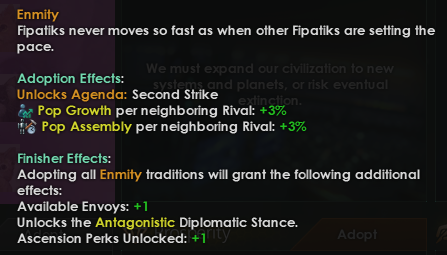
So many people to bear grudges against.
Some of the traditions will reward you for maintaining loads of rivals such as Rise to the Occasion.

Good news! We found a xenophobe, now we can afford to employ another scientist!
While the right side of the tree will be helping you compete against your Rivals.
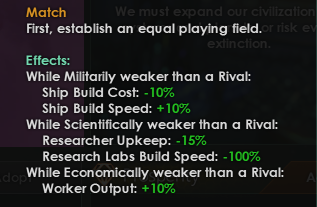
Rivaling stronger empires is always a good idea.
When you grab the tradition tree you also get access to a powerful agenda if you own Galactic Paragons. Since this Agenda is of a more tactical nature it will finish twice as fast as other tradition based agendas.

Give us war and nothing more!
And as a nice finish you get access to a new diplomatic stance granting you further benefits for rivaling the galaxy.

You get a rivalry and you get a rivalry!
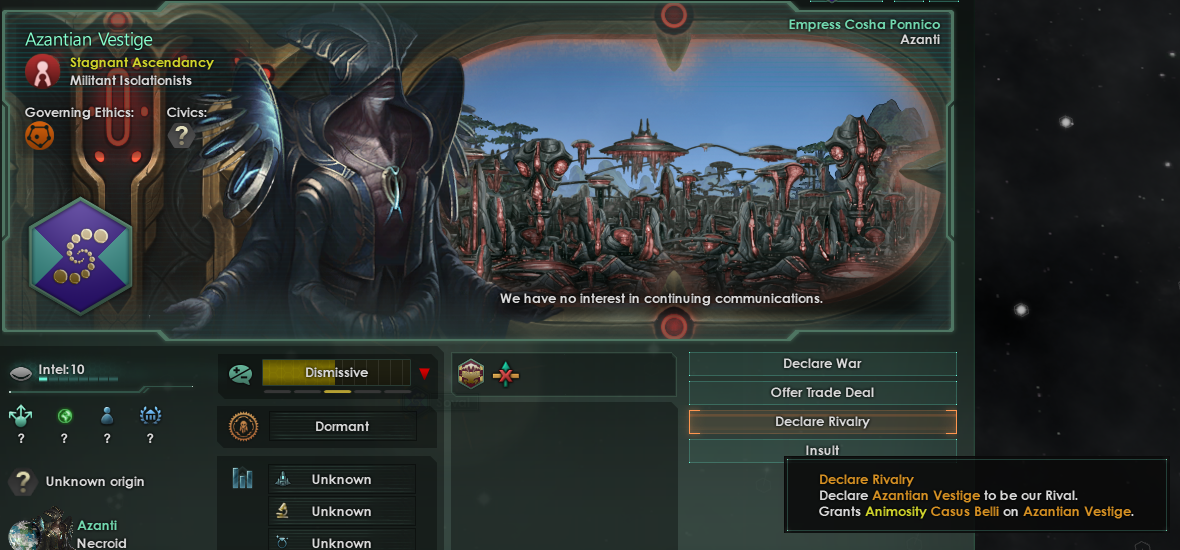
♫Dumb ways to die…♬
Another thing we haven’t done in a while is add more Negative Traits, the Humanoid Species Pack will now give you two! As well as a new fun positive one as well. First up we have Psychological Infertility, which can be taken with a lot of the positive pop growth traits in the game, as well as its mirror, Existential Iteroparity.

Those Unbidden are not the right mood!

The faster you kill them the faster they grow!
Finally for the players that really wanna try their luck (or just bully the servile species) there is now Jinxed!

The Tzynn saw a black cat cross the street, but didn’t understand the significance.
We also have two new portraits coming to the Humanoids pack.
Unlike Lithoids and Plantoids, where we wanted to add a more human-like variant of the phenotypes, the Humanoids pack was already full of… well… Humanoids.
So we decided to make two more to add more variety to the available portraits.

Dimorphism in this species is mostly in skin patterns and hair.
The second is a different take on “badass space elves”.
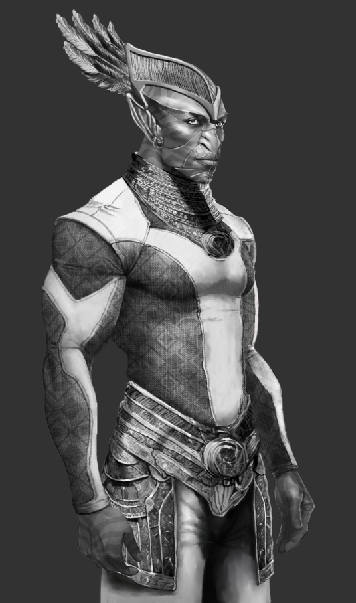

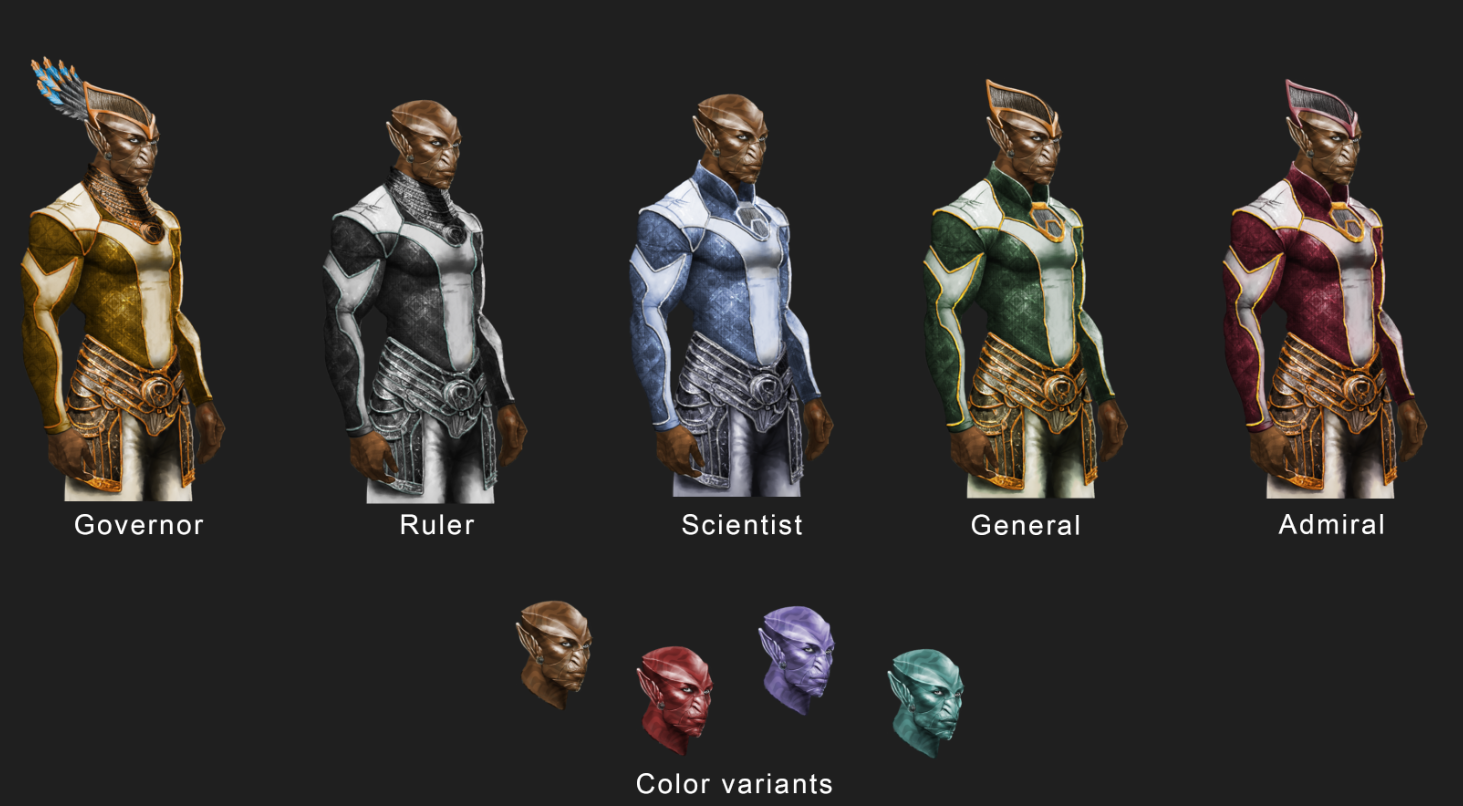

The Necroids Species Pack has already received a large number of improvements. Reanimated Armies, in particular, changed from being a very niche civic into a much more interesting one as Reanimators, and then was expanded to include Megacorps and Hives with Permanent Employment and Cordyceptic Drones.
The only one left out of the fun were machines.
Enter the Mechromancy Ascension Perk.
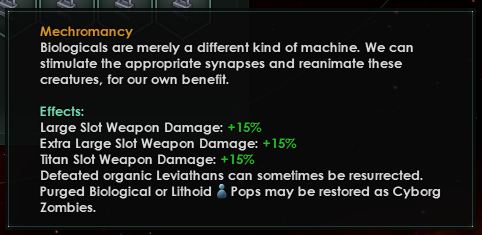
Have you tried turning it off and back on again?
Mechromancy has no prerequisites, so can be taken as a Machine Intelligence’s very first Ascension Perk.

Totally not placeholder artwork.
They can reanimate certain leviathans, and purged organic pops may be raised as cyborg zombies. Driven Assimilators treat these cyborg zombies as if they were assimilated for the purposes of pursuing Cybernetic Ascension.
One unintended consequence of the sources of Trade Value throughout the game was that Trade-focused empires ended up having more Merchants than we intended. To curtail this, and reduce the number of Ruler-strata jobs in these empires, we’re introducing two new jobs to the game.
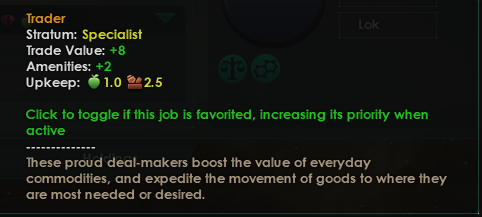
Traders, willing to buy and sell anything on the Galactic Market.
Traders replace Merchants from most sources and are also granted in place of Clerks for some buildings. These specialist strata jobs have an upkeep of 2 Consumer Goods and produce 8 Trade Value (plus some Amenities if you have the Commercial Enterprise Tradition).

Numistic Priests replace the Merchant and Priest jobs provided by the Numistic Shrine. These specialist strata jobs have an upkeep of 2 Consumer Goods and produce 6 Trade Value, 2 Unity and 2 Amenities. However, for the purposes of any bonuses provided to jobs, they count as both Traders and Priests.

Trade leads to Prophets, Prophets lead to Profits!
The humble Clerk job has been rebalanced and now produces 3 Trade Value and 3 Amenities instead of 4 Trade Value and 2 Amenities. Taking the Trickle Up Economics Tradition increases their output to 4 Trade Value and 4 Amenities, but no longer grants additional Clerk jobs.

A player fantasy that’s occasionally been requested from the community is the idea of a worker-led Corporate empire. After playing around the concept a bit (Should it be a new authority? An origin? A civic?), we decided on making a Worker Cooperative civic, without sharing too many features with Shared Burdens.

Collective Corporate Cooperation Creates Credits
For most of the game a Worker Cooperative empire should be entirely without the Ruler-strata as they replace their Executives and Managers with Stewards.

No rulers here!

Stewards replace both Executives and Managers
As these unique jobs provide Unity and small amounts of both Trade Value and Amenities, they’re fairly useful to have even on worlds that aren’t dedicated to Unity production.


Profits to the people!
The Employee Ownership Living Standard is much like Shared Burdens by sharing Political Power equally across the Strata, however instead of providing increased Happiness and faster Pop Demotion Time, it gives pops the same Trade Value production as Utopian Abundance and is further improved by a Tradition swap for the civic.

Meanwhile, the Mutual Aid trade policy allows your empire to reinvest their profits back into the upkeep for your pops. This allows some fairly powerful early game expansion if you’re running a Trade-focused build.
Eladrin immediately took this civic and twisted it into a Void Dweller Relentless Industrialist dystopia, screaming that “the invisible hand of the free market will handle the externalities”, so your utopian mileage may vary.
More improvements are being made to planetary automation.
Based on feedback we received (primarily from newer players), we’ve removed dedicated automation stockpiles from the game. Planetary automation will simply use resources from your empire stockpiles, removing one unintuitive step from the process as well as getting rid of some weird and unintended resource conversion quirks.
The automation settings panel now lets you restrict certain resources from use by the automation system, so you can do things like forbid the use of Rare Crystals if you have important plans for those.
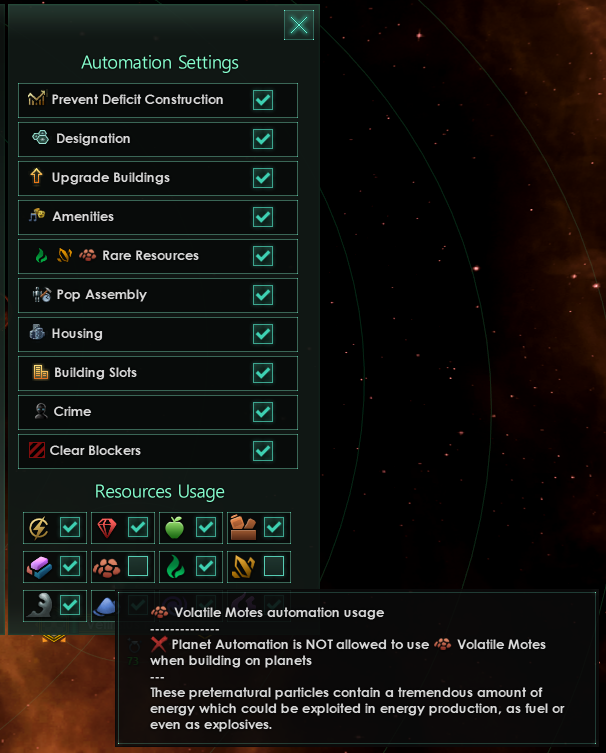
The Habitat experiment described in Dev Diary #306 has continued, and it’s looking positive towards inclusion in the 3.9 ‘Caelum’ update.
Following on from Eladrin’s directive to simplify my Habitat Prototypes and the feedback we’ve received, I’ve continued iteration on our planned rework for Habitats.
So what’s changed from 3.8…
Habitats as a Megastructure and Colony/Planet are limited to one per system in the form of a Habitat Central Complex megastructure which when built spawns a colonisable habitat and Major Orbital.
Once this has been constructed, additional Major Orbitals can be constructed around planets in the system and Minor Orbitals can be constructed around asteroids and moons in the system.
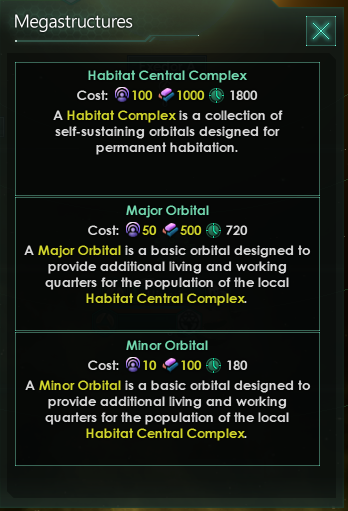
The megastructure build menu listing the options for Habitats

Detailed tooltips showing the requirements and effects of Habitat Megastructures.
When constructed, a Habitat Central Complex starts as size 6, and Habitation and Industrial Districts being uncapped. Research, Energy and Mining Districts are however limited to 3 × the number of deposits in the system that have an Orbital. Habitation Districts have also been changed to now provide 6 Housing, 2 Clerk/Maintenance Drone Jobs and +0.50 Building Slots.
If an Orbital is constructed around a planet, moon or asteroid with an Exotic Gas, Rare Crystal or Volatile Motes deposit, the deposit will automatically provide the jobs to collect the resources, without needing to construct a resource extraction building, as long as you have researched the relevant technology. While Orbitals constructed around Alloy, Zro, Dark Matter or other such deposits will automatically provide the resources as Habitats currently do.
As Orbitals are treated much like Mining/Research Stations in the system, they can be attacked by hostile forces but will be disabled when they hit 5% Hull Points (though crisis factions will instead outright destroy the Orbitals). When an Orbital is disabled, the Habitat Central Complex will gain 10% Devastation and a blocker depending on the type of Orbital.

Venting atmosphere into space is in breach of several GalCom ordinances!
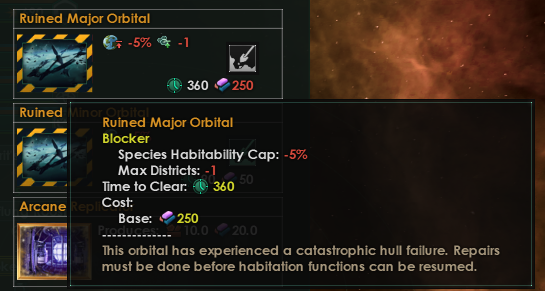
The penalty to Max Districts scales with the level of the Habitat.
Habitat Complexes can be upgraded through Planetary Decisions much like previously, except instead of increasing the Planet Size, the upgrades will now increase the Habitability (which is useful since Habitats now start at 40% Habitability) and boost the District and Building Slots provided by Orbitals.
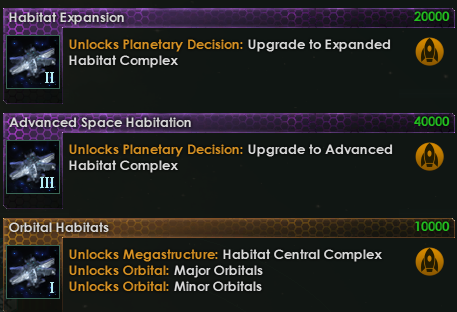
Habitat Technologies

Habitat Complex Upgrade Decisions
The effects and modifiers for both Void Dweller Origin and Voidborne AP have been reworked to take these changes into account, allowing for Void Dwellers to inherit most of the effects of the Voidborne AP.
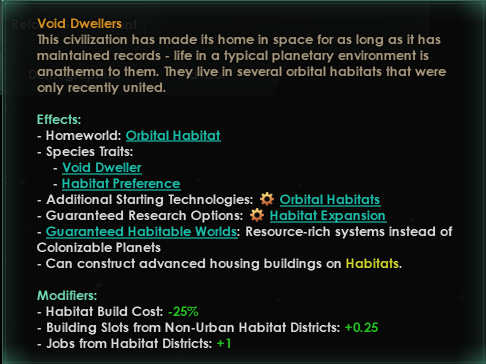
Effects and Modifiers for Void Dwellers
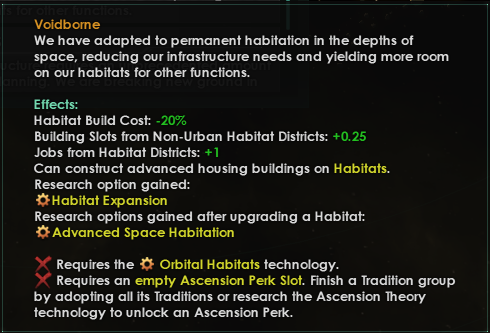
Effects for the Voidborne AP
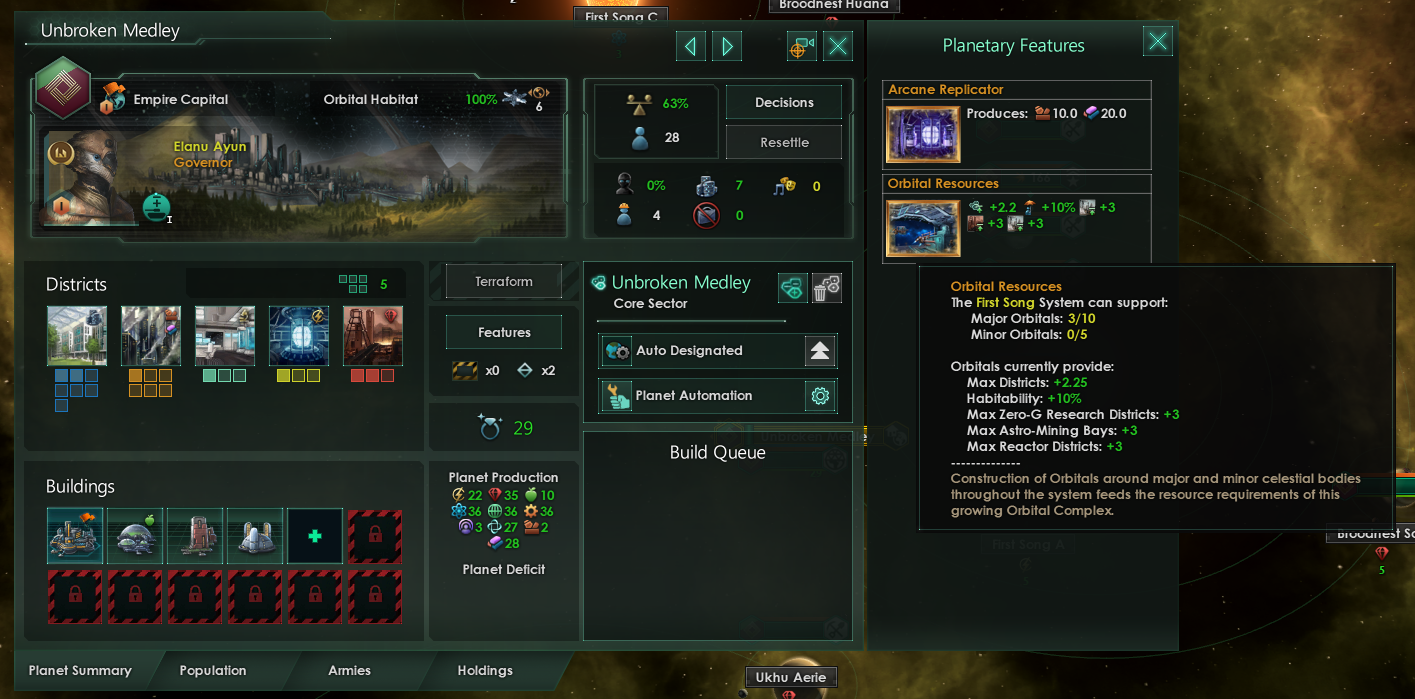
The initial Habitat Complex of a Void Dweller empire.
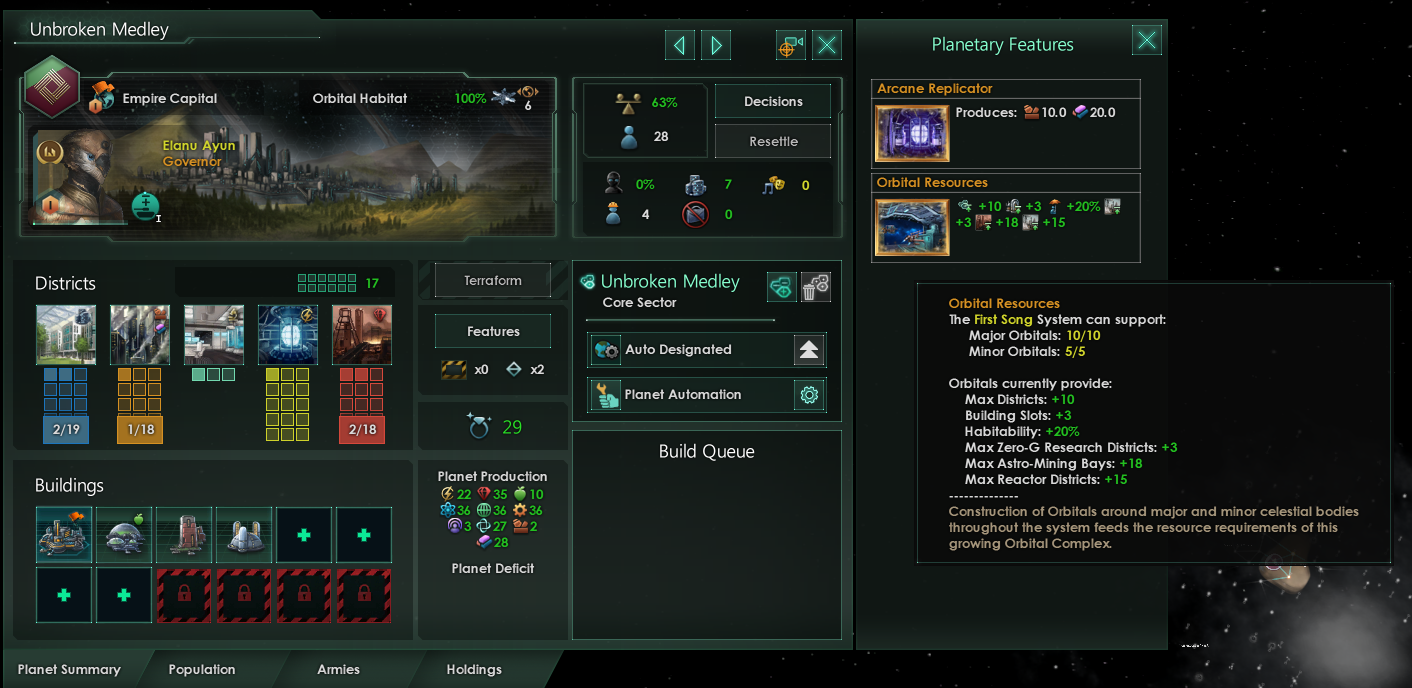
The same Habitat Complex after constructing all available Orbitals and fully upgrading it.
While updating the Void Dweller starting conditions, we ran into an old bug – Void Dwellers with the Sol system would spawn the guaranteed habitable worlds if that setting was enabled, though the planets would be of a random planet class, but those with the Trinary Void Dweller system would not spawn these systems. To fix this, we’ve updated both starting systems for Void Dwellers so that the first world is replaced with a frozen planet with a research deposit and a large number of research deposits scattered throughout the system while the second world is replaced with a molten world with an alloy deposit and a large number of mineral and energy deposits scattered throughout the system. This means that with the guaranteed habitable worlds setting, Void Dwellers are instead guaranteed a number of resource rich systems designed for setting up habitat complexes.
We’ve decided that an Open Beta would be a good opportunity to gather more hands-on feedback about the system.
The beta includes early access to all of 3.9.0. Please visit the Paradox Forums to view the entirety of the Preliminary Changelog.
Go to your Steam library, right click on Stellaris -> Properties -> betas tab -> select “stellaris_test – 3.9 Open Beta” branch.
We’ve set up a feedback form here to consolidate your comments and suggestions.
Next week we’ll be reviewing how the Open Beta has been going, and if there are any additional changes planned as a result of it.
SPOILER: QUEST COMPLETE
[expand type=showmore]
[/expand]


